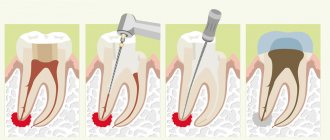July 18, 2011
Fluoride is found in water, foods, and even soil in the form of minerals called fluorite and fluorapatite. However, most often a person encounters industrially produced fluoride compounds, which are added to a variety of products to protect teeth.
However, fluoride doesn't just save teeth. Fluorine compounds are included in some blood substitutes because they are harmless to the body and have a good ability to dissolve oxygen and other gases. Other organofluorine compounds are found in artificial heart valves.
Why is it needed?
The main role of fluoride in maintaining human health is maintaining the health of tooth enamel
and
preventing caries
.
Bacteria that live in the mouth feed on sugars in food and produce acid that erodes enamel. Fluoride prevents this destruction by preserving minerals in the enamel. It is able to accumulate in already damaged areas of enamel and strengthens it - this process is called remineralization
. Together with calcium and phosphorus, fluoride also protects bones from the development of osteoporosis. Fluoride also helps the body absorb iron.
30.12.2021 Walking outdoors in winter has health benefits
Winter is one of the most wonderful times of the year: snow, trees wrapped in sparkling frost, and frosty air. It is at this time of year that it is very warm and safe to be at home; you don’t want to go outside at all. Despite this, spending time in the fresh air and ventilating the room is simply necessary, otherwise a loss of energy and a bad mood will be guaranteed.
30.12.2021 Proper nutrition for pregnant women
Healthy nutrition is the most important component of quality of life. It is understood as an integral indicator of a person’s mental, physical and social functioning. Organizing proper nutrition for pregnant women is one of the important conditions for the normal course and successful outcome of pregnancy, maintaining the health of the pregnant woman and ensuring adequate growth and development of the fetus, and subsequently the born child.
30.12.2021 10 habits that will help you stay healthy during the rise in the incidence of influenza and ARVI
FLU and ARVI remain the most common infections. In the autumn-winter period, the circulation of influenza viruses and other respiratory viruses is activated, which are quickly transmitted from person to person by airborne droplets, causing mass morbidity in the population. What these viruses have in common is damage to the upper respiratory tract of a person, accompanied by a runny nose, sore throat, and symptoms of intoxication, but there are also features of the clinical picture that a doctor can distinguish.
30.12.2021 Labeling requirements for red caviar
One of the most popular New Year's dishes is red caviar. When choosing red caviar, you need to pay attention to the following points in order to purchase a high-quality and safe product.
30.12.2021 Happy New Year!
Congratulations from the chief physician of the Federal Budgetary Institution of Health "Center for Hygiene and Epidemiology in the Tyumen Region"
30.12.2021 Prevention of acute intestinal infections during the New Year holidays
New Year's holidays are a great reason to take a break from everyday work and celebrate the arrival of the New Year with your family or in a noisy company of friends. And, of course, traditionally these events are not complete without a hearty festive feast.
29.12.2021 "Traffic light" of food products
Two years ago, at the beginning of June 2022, a project was launched in Russia to voluntarily label products with a color scale depending on their sugar, fat and salt content. Recommendations for manufacturers were prepared by Rospotrebnadzor.
24.12.2021 Requirements for marking and quality of felt boots
Valenki are winter shoes made from felted wool for children and adults. Any shoes must not only be of high quality, but also comply with mandatory regulatory requirements.
Thus, according to GOST 18724-88 “Felted coarse-wool footwear,” the marking should include:
24.12.2021 Results of the “hotline” on issues of quality and safety of children's products and New Year's gifts
During the period from December 6 to December 17, 2022, a hotline was organized at the Center for Hygiene and Epidemiology in the Tyumen Region on issues of quality and safety of children's products and New Year's gifts.
As part of the hotline, specialists from the Center and its branches distributed 550 leaflets, held 2 lectures, 1 round table, and 28 consultations.
24.12.2021 How to disinfect the air from viruses?
The most famous technology is disinfection using ultraviolet light. Almost everyone has heard that a UV lamp destroys pathogens. This is exactly how bactericidal recirculators work - the only devices from the group of disinfectants that are well known to many. Manufacturers offer quite a few models of recirculators, but in essence they all represent a kind of housing with a built-in fan and an ultraviolet lamp.
24.12.2021 Labeling of alcoholic products
When selling alcoholic products, mandatory requirements regarding their labeling must be observed.
The labeling of alcoholic products must contain mandatory information in accordance with the requirements of Chapter VIII of the Technical Regulations of the Eurasian Economic Union of the EAEU No. 98 “On the safety of alcoholic products” and Article 4 of the Technical Regulations of the Customs Union TR CU 022/2011 “Food products regarding their labeling”.
22.12.2021 Rules of "respiratory etiquette"
Respiratory etiquette is the norms of behavior in society that must be observed in crowded places in order to prevent diseases transmitted by airborne droplets. The most common diseases are ARVI, influenza and coronavirus.
22.12.2021 Dietary Fiber, Sources and Benefits
Dietary fiber is food components that are not digested by the digestive enzymes of our body, but can be processed by normal intestinal microflora. Dietary fiber is a combination of polysaccharides and lignin that are not digested by endogenous secretions of the human gastrointestinal tract.
22.12.2021 Labeling of fruits and vegetables. Tips for choosing
When buying vegetables, fruits and berries, you need to pay attention to the appearance, smell, color and consistency of the product. The color of the fruit must be characteristic of the given species, have no signs of spoilage or rotting, and no damage to the skin. Ripe fruits have a strong pleasant smell. Preference should be given to purchasing seasonal vegetables and fruits; early ones are likely to have a high nitrate content.
22.12.2021 Healthy eating. Vitamin E during pregnancy
Healthy nutrition is nutrition that ensures human growth, normal development and vital activity, promoting health and preventing diseases. A woman’s healthy diet in itself is a prevention of pregnancy complications. For healthy women, no diet is required in the first half of pregnancy; maintaining a healthy diet is important. In the first half of pregnancy, 4 meals a day are the most physiological.
22.12.2021 Healthy eating. Rational nutrition for knowledge workers
Healthy nutrition is nutrition that ensures growth, normal development and vital activity of a person, promoting his health and preventing diseases. Following a healthy diet coupled with regular exercise reduces the risk of chronic diseases and disorders such as obesity, cardiovascular disease, diabetes, high blood pressure and cancer.
22.12.2021 How to avoid getting infected if there is a sick person in the house?
Influenza and ARVI are diseases that are transmitted by airborne droplets and are caused by various pathogens. Causative agents of acute respiratory infections are mainly transmitted from person to person through coughing or sneezing, and infection through household items is also possible.
17.12.2021 Violation of deadlines for installation of kitchen units
A citizen contacted the Consultation Center for the Protection of Consumer Rights because his kitchen unit was not installed within the period established by the contract. When analyzing the available documents and oral explanations, it was found that the contractor assembled the kitchen set only partially, without a countertop and insertion of household appliances. This circumstance does not allow the consumer to use the kitchen, prepare food and wash dishes for more than 4 months.
16.12.2021 Volunteers for consumer protection
As part of the “hotline” on issues of the quality and safety of children's products, the choice of New Year's gifts, the consultation center for the protection of consumer rights in the city of Ishim, together with a group of volunteers, carried out actions to protect consumer rights.
08.12.2021 Rules for choosing dairy products
To make the right choice of dairy products from the variety of assortments on the retail shelf, it doesn’t hurt to take on board the following useful recommendations:
- Back
- 1
- 2
- 3
- 4
- 53
- Forward
As it turns out?
Fluoride can enter the body through topical use
of toothpastes, rinses and special dental preparations containing it.
They are applied directly to the teeth and are actively absorbed by the enamel. It is especially important to use such drugs in young children – during the period of growth and formation of permanent teeth. They are also needed by adults - with the development of caries, smokers, lovers of sweets and those for whom dentists perform dental restoration, as well as implantation of implants or installation of crowns and bridges. But fluoride can also be obtained through food
- from foods rich in it or through
drinking water
. It is absorbed in the digestive tract, enters the bloodstream and is absorbed by the tissues of teeth and bones. People receive most of their fluoride from water and about 20 percent from food.
Impact on general health
Caries is the most obvious, but by no means the only dental problem. Bacterial plaque that forms on the surface of teeth can also cause gum disease. Unfortunately, many people do not pay enough attention to the health of their gums - and completely in vain, because it significantly affects their overall health. With periodontal diseases, bacteria can spread from the oral cavity through the bloodstream to other organs and tissues, which often causes atherosclerosis, the development of cardiovascular diseases and stroke.
What if it's not enough?
The main signs of fluoride deficiency in the body are the active development caries
.
of periodontal disease
appear - inflammation and destruction of the gum tissue around the tooth.
This disease is caused by the activity of harmful microorganisms living in the oral cavity, which is usually suppressed by fluoride. Also, with a lack of fluoride, bone tissue begins to deteriorate - osteoporosis
.
However, if you consume large amounts of fluoride-containing products and products, over time, a change in the color of the enamel may occur - fluorosis
. And in more serious cases, there is a decrease in mobility and pain in the joints - skeletal fluorosis.
Fluoride levels in water
Due to the toxicity of the gas, the fluoride content in drinking water is strictly standardized. In 1994, according to WHO standards, a maximum permissible value was established that should not be exceeded: the maximum permissible concentration for fluorine in water is 0.5 mg/l. In Russia, the maximum permissible concentration of fluorine for water is established by GOST 2874-90.
The normalized presence of fluoride - the amount of fluoride in drinking water - depends on the area and climate. Where there is year-round heat, where people drink a lot of liquid, the recommended figure is 0.5 mg/l. In the northern territories, the norm is set at no higher than 1 milligram. In the middle zone in areas with a temperate climate, it is recommended to stick to 0.7 mg/l.
The requirements are not met everywhere. Almost a third of the world's population drinks liquids in which the concentration of fluoride in water is above 1.5 mg/l. It is imperative to check the exact composition of elements and compounds in the aqueous solution and remove excess fluoride in tap or artesian water.
In Indian, South American and Kenyan waters there is a dangerous excess of fluoride - 25 mg per liter. In many southwestern regions of Ukraine, extremely low F(-) levels are observed. In Russian underground deposits, the fluorine content in water is increased, much more than 1.5 mg/l. In the Moscow region, in the Urals it reaches 4.4 ml/l. In water bodies of Kazakhstan and Azerbaijan, the value is critical, up to 11 ml/g.
In surface water sources the concentration is much lower, up to 0.3 mg/l. In particularly hazardous areas, the saturation of aqueous solutions with F(-) ions can exceed 65 mg/liter. Sea salt waters are less dangerous; the presence of fluorides in them is low, only 1.1-1.4 mg.
For areas with a low fluoride content (below the optimal fluoride content in water), health care recommends adding them artificially - fluoridating the aqueous solution before use. Fluorides are added in small quantities: micrograms or even nanograms.
Indications for fluoridation are:
- low maximum permissible concentration of water for fluorine,
- lack of regional programs for food fluoridation,
- medical indicators - a large percentage of caries diseases in this area.
For areas where F(-) ions are present in excess, you need to choose ways to reduce the fluoride content in water.
In addition to the fact that public utilities responsible for water supply are required to monitor the maximum permissible concentration for fluorine in water, each person can independently check the composition of the water and purify it of all harmful substances before use.











